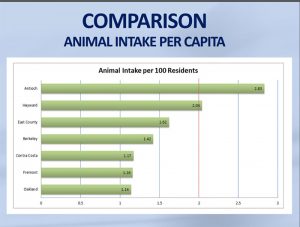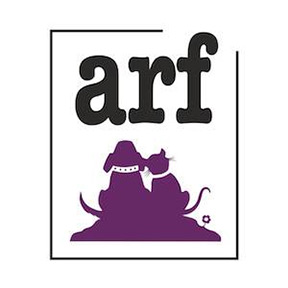On Tuesday, the Antioch City Council unanimously approved a recommendation to increase staffing within the Animal Services Department in an effort to bring services in-house.
Under the recommendation of non-profit organization Tony La Russa’s Animal Rescue Foundation, the City has been working on processes, outreach efforts, and finding ways to improve the overall shelter conditions and operations for the past three months. The agreement will continue for another 9-months.
One of the recommendations were to bring in a part-time veterinarian (3-days) and a full time veterinary technician to provide animal care services. In total, along with other recommendations, it will cost the city of Antioch $202,575 annually.
In 1978, Measure A approved the City of Antioch to create its own animal shelter that separated it from the County. In 1991, Antioch Animal Service building was constructed but no major capital improvements have been made since that time.
Captain Tammany Brooks highlighted a portion of the Citygate report in 2009 highlighting that a specific quote sticks out from the report.
“If the City simply continues the animal control program the way it is today, staffing will become more skeletal, community education and outreach programs will remain limited and ineffective, the animal shelter will be increasingly undersized for the city’s population, shelter maintenance will be deferred, and the relationship between the City and its animal welfare constituents will become frustrating, if not contentious. The City’s unwanted pet population will continue to rise and more and more animals will suffer” – Citygate Report 2009.
Captain Brooks said that in reality, that became a reality for the City. In response, in June of 2016 he requested help for additional staffing which included 4 part-time animal care attendants and a full-time office assistant with a fiscal impact of $131,000—achieved through savings.
In September, Animal Services met with Tony La Russa’s Animal Rescue Foundation (ARF) and offered to join into a partnership to provide staffing and resources for 12-months. The council approved the MOU.
 Brooks called the agreement a “three pronged” partnership
Brooks called the agreement a “three pronged” partnership
“Maddies Fund being the capital source, ARF has supplied the administrative tools and leadership experience to move the Antioch Animal Services forward. The Animal Services staff provided the elbow grease to get things done based on recommendations by ARF,” said Brooks. “When ARF came in they told us immediately that they would be looking at guidelines of care for animals which is a handbook which is put together by an association shelter veterinarians.”
Brooks further highlighted when ARF came in and reviewed the operation and staffing where they came up with three immediate roadblocks that had to be dealt with.
- The intake per capita of animals is extremely high (more than double Contra Costa)
- They are the only shelter in East Contra Costa
- Rapid population growth which has created space and capacity limitations
 According to Captain Brooks, the Animal Services Capacity is 101 animals (55 dogs/46 cats). With staffing, they can only hold 85 animals.
According to Captain Brooks, the Animal Services Capacity is 101 animals (55 dogs/46 cats). With staffing, they can only hold 85 animals.
Brooks said that once they went over all the data, ARF helped them come up with a plan which started with finding ways to reduce inflow into the shelter.
“We began inviting rescue partners to pull as many animals as they could within a short period of time. They did so by providing financial incentives for the harder to adopt animals such as pit bulls, Chihuahuas, animals with medical problems or behavioral issues,” explained Brooks. “We also held free public adoption events over six weeks there were 140 animals adopted and 27 were rescued.”
Brooks highlighted that they are focused on Stage 2 where they want to create medical and behavior matrixes based on Contra costa Animal Services and recommendations from Antioch veterinarians and trainers.
“When an animal comes in, the goal is to identify a pathway immediately and begin moving that animal to a desired outcome,” said Brooks. “We need to implement industry standard daily rounds and move towards hiring a part-time doctor of veterinary medicine who specializes in shelter care as well registered veterinary tech.”
ARF is willing to fund the position for up to 9-months.
Brooks further highlighted how ARF led a “cleaning blitz” of Antioch Animal Services with new cleaning equipment by providing industry standard equipment while installing portals to meet industry shelters. Upgraded housing supplies such as soft bedding, cat toys and enrichment items.
The plan going forward is to work to remove barriers to adoption by modernizing the process which will help them reduce adoption fees while working on improving communication with rescue partners and creating agreements with organizations. ARF also plans on focusing on community humane education while creating a volunteer program.
Captain brooks also noted the Antioch Animal Shelter has now increased its hours and last Friday was the first Friday its been open in sometime—the hours will be 10:00 am to 2:00 pm to help with adoption opportunities or claim their lost animal.
“We need to remember, we have a 12-month partnership which we are 3-months into. We will re-evaluate in the end and establish a new mission statement,” said Brooks.
 During the partnership, ARF has provided 1-on-1 guidance to shelter supervisor and Lieutenant 2-3 days per week while building a volunteer and foster program. They have assisted with volunteer efforts, training’s, free spay/neuter for shelter for 9-months while helping build community partners and relationships.
During the partnership, ARF has provided 1-on-1 guidance to shelter supervisor and Lieutenant 2-3 days per week while building a volunteer and foster program. They have assisted with volunteer efforts, training’s, free spay/neuter for shelter for 9-months while helping build community partners and relationships.
“I cannot speak highlight enough of Elena Bicker, Stephanie Erickson and Sara Bragg who is the community program director, they are true professionals, they have been a wonderful resource and all stars as far as I am concerned, they have been wonderful,” said Brooks.
He noted three alternatives for animal services
First, outsources adoptions and rescue responsibilities to non-profits. Brooks says that was not a viable option, the non-profits have competing priorities as opposed to running an animal shelter. The cost to care for non-profits is usually higher. There is also little interest in providing services.
The second was to return animal services to the county which isn’t a preferred option because county leadership is not even interested.
“I have Chief Cantando’s permission to say this, but he has been to county chiefs meetings throughout the county and they have expressed their displeasure at the level of service they are receiving from county animal services,” said Brooks. “Third, it’s a more expensive option”.
In working with ARF, additional staffing should be focused on providing animal care to the animals which has changed the request to the city council where they are now asking for a part-time Doctor of Veterinary Medicine (24-hours) and a full-time registered Veterinary Tech in house and ask to maintain current staffing levels approved in June now become permanent.
 Under this model, $197,000 noting that currently under a veterinary locally, they are getting 3-hours of service in the shelter per week. 1-hour three hours per week is the service we get explained Brooks—that cost was $125,000.
Under this model, $197,000 noting that currently under a veterinary locally, they are getting 3-hours of service in the shelter per week. 1-hour three hours per week is the service we get explained Brooks—that cost was $125,000.
“We are looking at a net cost increase of $71,723,” said Brooks. “Yes this is an increase, but the level of care these animals would receive is significantly more.”
Overall, the proposed budget increase would be $202,575 for a total of $740k it spends each year on animal services. He also says this proposal would be $250k cheaper than if they went to the county.
Brooks further highlighted that if the city approves this model, which they did not seek in the past because the Doctor of Veterinary Medicine and Veterinary Tech had no place for them to work because their surgery room which is not up to code for sanitation and could not provide care in the room, but now ARF is willing to help.
“What ARF has agreed to do if we go to this model, in conjunction with capital supplied by Maddies Fund, is they would like to provide all the capital improvements to make that surgery room a working room that can be used by the onsite Doctor of Veterinary Medicine and Veterinary Tech, and supply all the medical equipment to go inside that surgery room,” said Brooks. “ARF is willing to supply all of that so we can begin this model of veterinary care but only do so if we can commit to keeping that level of care after our agreement with ARF has expired.”
Antioch Mayor Sean Wright offered praise to ARF.
“I would like to give a big thank you to ARF,” said Wright. “I’d also like to mention all our volunteers who work at our shelter, they are wonderful as well.”
Councilwoman Monica Wilson shared her concern over the quantity of intake suggesting that all of East County is using their animal shelter.
“How do we work with our fellow East County cities either contribute or help. I am thinking someone in Brentwood who wants to surrender an animal would want to come to Antioch before they go to Martinez,” said Wilson. “Is there any type of solution to that?”
Brooks stated that has crossed people’s mind and have had examples but says it’s not quantifiable or not because they receive animals in a variety of ways.
“Our focus right now is to reduce the intake specifically looking at Antioch resources,” said Brooks. “Low cost spay and neuter, education outlook and help people become responsible pet owners and reduce pet population… there is a number of things we can do to improve control.”
Wilson also noted she was happy to see all the protocols set in place for volunteers or process now put in place to foster the communication.
Councilwoman Lori Ogorchock asked about the amount paid per capita to the county and if they could get that back. Brooks stated they have confirmed they are not paying that amount.
Councilman Tony Tiscareno thanked ARF calling their efforts “tremendous”.
“In principle I agree with everyone on this report and it’s something I would support. Again we need to talk about how we can sustain long-term. We want to make sure that if we do hire these positions that we are able to maintain and sustain for a long-time. I am hoping we can do something like that,” said Tiscareno. “If we do happen to come to an agreement, knowing that ARF is expiring after 9-months, what is your consideration in participating further? I’d love to see the continuation of what ARF is doing; I don’t want to see them going away.”
Mayor Wright stated he looked into the numbers and they are the East County shelter.
“The way the numbers play out we as East Contra Costa residents make up approximately 28% of the population of the county and our intake, looking at 2015 numbers, shows we are 23% of the Contra Costa intake,” said Wright. “Which means some East Contra Costa residents go to Martinez, but there is no way Antioch residents who make up a little less than 10% is reaching 23% of the intakes county wide. It’s not plausible from a sheer statistics standpoint. I think we have an opportunity to make a case to the county that we are subsidizing animals and animal safety in east Contra Costa County.”
Wright noted ARF is asking us to show our hand.
“I am inclined to say yes and go forward to find where that $200,000 will come from,” said Wright. “There is no extra money lying around, it’s not like we are going to find $200,000 on the ground so it’s a matter of prioritizing as a council. But when you put towards something you are going to have to take it from somewhere else.”
The council voted 5-0 to accept the staff report and the recommendations by ARF and the priority to hire a Doctor of Veterinary Medicine (24-hours) and a full-time registered Veterinary Tech.
To watch the report given by Captain T. Brooks:
http://www.ci.antioch.ca.us/CityGov/CouncilMeetings/021417/
For more information on ARF – click here.

